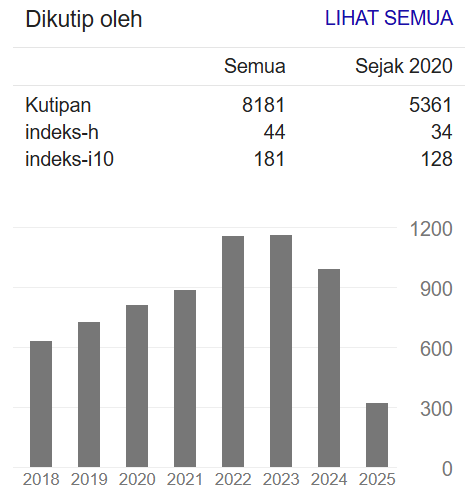ANALISIS GEOGRAPHIC INFORMATION SYSTEM FAKTOR RISIKO BAYI BERAT BADAN LAHIR RENDAH (BBLR) PADA IBU HAMIL DENGAN MALARIA: STUDI KASUS
DOI:
https://doi.org/10.34011/jmp2k.v34i3.2076Keywords:
geographic information system, low birth weight, malaria, pregnant womenAbstract
Papua has the highest rate of malaria cases among all provinces in Indonesia. Malaria is a scourge, especially among vulnerable groups, including pregnant women. Pregnant women with malaria increase the risk of giving birth to Low Birth Weight (LBW). This study aimed to analyze geographic information system risk factors for LBW in pregnant women with malaria. This research method was observational analytics using a matched case-control design. The study encompassed pregnant women residing in the Sentani health center working area, who were both afflicted with and unaffected by malaria, and sought outpatient care at the health center. With a population of 104 pregnant woman, and the sample used was the Total sampling technique. This study found that the distribution of LBW cases tends to increase if there are many malaria incidents in the area. The distribution pattern of malaria cases shows a tendency to gather in areas with high rainfall, areas with low air humidity and areas with high air temperatures, namely Nolokla and Asei Villages. To maintain the health of mothers and babies and avoid possible risks, it is necessary to increase supervision and vigilance in the months where the intensity of rain increases, namely from November to March, where rainfall is also related to humidity and temperature so that it affects the sustainability of mosquito larvae habitat
References
Kemenkes RI, Kemenkes RI. In Lembaga Penerbit Balitbangkes, 2018.
S. Lestari, “Lingkungan Rumah Berhubungan Dengan Malaria Pada Ibu Hamil,” J. Keperawatan Silampari, vol. 6, no. 2, pp. 1205–1217, 2023, doi: 10.31539/jks.v6i2.4646.
H. M. Ngongo, “Hubungan Antara Perilaku Dan Kondisi Lingkungan Dengan Kejadian Malaria Di Beberapa Daerah Di Indonesia,” J. Keperawatan Sumba, vol. 1, no. 1, pp. 61–70, 2022, doi: 10.31965/jks.v1i1.863.
H. Putra, “Faktor Yang Memengaruhi Kejadian Malaria Di Wilayah Kerja Puskesmas Leuser Kabupaten Aceh Tenggara Provinsi Aceh Tahun 2019,” J. Komunitas Kesehat. Masy., vol. 1, no. 2, pp. 40–50, 2020, doi: 10.36090/jkkm.v1i2.589.
W. J. Pattipeilohy et al., “Analisis Perubahan Pola Musim dan Distribusi Frekuensi Curah Hujan di Sentani Analysis of Changes in Seasonal Patterns and Distribution of Rainfall Frequency in Sentani,” vol. 5, pp. 1–9, 2024.
A. Santjaka, Pendekatan Model Kausalitas. Yogyakarta: Nuha Medica, 2013.
K. Mohammed et al., “Spatial analysis of climatic factors and plasmodium falciparum malaria prevalence among children in Ghana,” Spat. Spatiotemporal. Epidemiol., vol. 43, p. 100537, 2022, doi: https://doi.org/10.1016/j.sste.2022.100537.
Mardiana and D. Anwar Musadad, “Pengaruh perubahan iklim terhadap insiden malaria di Kabupaten Bintan Kepulauan Riau dan Kabupaten Banggai Sulawesi Tengah,” J. Ekol. Kesehat., vol. 11, pp. 52–62, 2012.
D. E. Ekpa, E. A. Salubi, J. A. Olusola, and D. Akintade, “Spatio-temporal analysis of environmental and climatic factors impacts on malaria morbidity in Ondo State, Nigeria,” Heliyon, vol. 9, no. 3, p. e14005, 2023, doi: https://doi.org/10.1016/j.heliyon.2023.e14005.
S. Sulasmi, D. E. Setyaningtyas, A. Rosanji, and N. Rahayu, “Pengaruh curah hujan, kelembaban, dan temperatur terhadap prevalensi Malaria di Kabupaten Tanah Bumbu Kalimantan Selatan,” J. Heal. Epidemiol. Commun. Dis., vol. 3, no. 1, pp. 22–27, 2019, doi: 10.22435/jhecds.v3i1.1794.
R. Nababan and S. R. Umniyati, “Faktor lingkungan dan malaria yang memengaruhi kasus malaria di daerah endemis tertinggi di Jawa Tengah : analisis sistem informasi geografis Environmental and behavioral factors affecting malaria cases in high endemic area of Central Java : a geographi,” Ber. Kedokt. Masy., vol. 34, no. 1, pp. 11–18, 2018.
H. Iklim et al., “Perhimpunan Entomologi Indonesia,” J. Entomol. Indon, vol. 7, no. 1, pp. 42–53, 2010.
L. C. Garba et al., “Spatial features of malaria in the lowland and nearby highland areas of Taraba State, Nigeria,” Sci. African, vol. 22, p. e01969, 2023, doi: https://doi.org/10.1016/j.sciaf.2023.e01969.
S. Humaira, N. Nurjazuli, and M. Raharjo, “Hubungan Lingkungan Dan Perilaku Terhadp Kejadian Malaria Di Provinsi Aceh,” J. Kesehat. Lingkung. Indones., vol. 23, no. 2, pp. 241–248, 2024, doi: 10.14710/jkli.23.2.241-248.
E. Watmanlusy, M. Raharjo, and N. Nurjazuli, “Analisis Spasial Karakteristik Lingkungan dan Dinamika Kepadatan Anopheles sp. Pengaruhnya terhadap Kejadian Malaria di Kecamatan Seram Barat Kabupaten Seram Bagian Barat Maluku,” J. Kesehat. Lingkung. Indones., vol. 18, no. 1, p. 12, 2019, doi: 10.14710/jkli.18.1.12-18.
L. Isnaeni, S. L. Dian, W. M. Arie, and A. Udiyono, “Faktor Perilaku Dan Faktor Lingkungan Yang Berhubungan Dengan Kejadian Malaria Di Wilayah Kerja Puskesmas Gebang Kabupaten Purworejo,” J. Kesehat. Masy. UNDIP, vol. 7, no. 2, pp. 31–38, 2019, [Online]. Available: http://ejournal3.undip.ac.id/index.php/jkm
T. Z. Nigussie, T. Zewotir, and E. K. Muluneh, “Effects of climate variability and environmental factors on the spatiotemporal distribution of malaria incidence in the Amhara national regional state, Ethiopia,” Spat. Spatiotemporal. Epidemiol., vol. 40, p. 100475, 2022, doi: https://doi.org/10.1016/j.sste.2021.100475.
S. Adu-Prah and E. Kofi Tetteh, “Spatiotemporal analysis of climate variability impacts on malaria prevalence in Ghana,” Appl. Geogr., vol. 60, pp. 266–273, 2015, doi: https://doi.org/10.1016/j.apgeog.2014.10.010.
R. Saxena, B. N. Nagpal, A. Srivastava, S. K. Gupta, and A. P. Dash, “Application of spatial technology in malaria research & control: Some new insights,” Indian J. Med. Res., vol. 130, no. 2, pp. 125–132, 2009.
F. Ahmad, L. Goparaju, and A. Qayum, “Studying Malaria Epidemic for Vulnerability Zones: Multi-Criteria Approach of Geospatial Tools,” J. Geosci. Environ. Prot., vol. 05, no. 05, pp. 30–53, 2017, doi: 10.4236/gep.2017.55003.
S. S. Maya Tindige, Joy Sambuaga, “Studi Spasial Keberadaan Breeding Places Dengan Kejadian Malaria Di Desa Bulude Kecamatan Kabaruan Kabupaten Kepulauan Talaud,” Repos. Poltekkes Manad., 2020.




